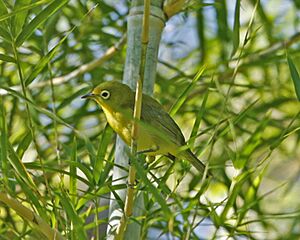Lemon-bellied white-eye facts for kids
The lemon-bellied white-eye (Zosterops chloris) is a small, active bird. It belongs to the Zosteropidae family, which is known for birds with a ring of white feathers around their eyes. This bird is special because it is found only in Indonesia.
Quick facts for kids Lemon-bellied white-eye |
|
|---|---|
 |
|
| Conservation status | |
| Scientific classification | |
| Genus: |
Zosterops
|
| Species: |
chloris
|
Contents
Where Lemon-bellied White-eyes Live
The lemon-bellied white-eye lives on many islands in Indonesia. You can find them from the Sunda Strait all the way to the Aru Islands. They live on some of the Lesser Sunda Islands and parts of Sulawesi. They also live on many smaller islands.
However, you won't find them on bigger islands like Borneo, Java, Sumatra, or Timor. This bird prefers certain types of places to call home.
Their Favorite Homes
These birds love warm, wet places. Their natural habitats include lowland forests where it's often moist. They also live in mangrove forests, which are special forests that grow in salty water along coastlines.
On some islands, like Buton and Kabaena, these birds seem to stick to areas near the coast. They might even prefer places where the environment has been changed a bit, like disturbed areas.
What Lemon-bellied White-eyes Eat
The lemon-bellied white-eye has a varied diet. They enjoy eating small invertebrates, which are creatures without backbones, like insects. They also eat different kinds of fruit.
Besides that, they drink nectar from flowers. Nectar is a sweet liquid that gives them energy.
What Lemon-bellied White-eyes Look Like
The lemon-bellied white-eye is a small bird, usually about 11 to 12 centimeters long. That's about the length of your hand! They have strong, dark grey legs that help them perch and move around. Their beak is dark in color.
Their back and upper parts are a yellow-olive color. But their most noticeable feature is their bright yellow belly, which gives them their name. They also have the classic white ring around their eyes, which is common for white-eye birds.


